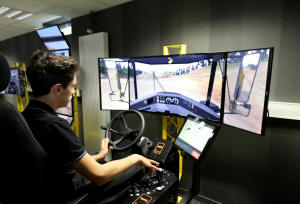Driving simulator helps teens with ADHD keep eyes on the road - study
 Send a link to a friend
Send a link to a friend
 [December 01, 2022]
By Shawana Alleyne-Morris [December 01, 2022]
By Shawana Alleyne-Morris
(Reuters) - A computer simulation program for teen drivers with
attention-deficit/hyperactivity disorder (ADHD) helped them learn to
keep their eyes on the road and resulted in fewer accidents or near
collisions for a group at particularly high-risk when behind the wheel,
according to a study published on Wednesday.
By providing feedback when teens looked away from the road for two
seconds or more, the training reduced the frequency of these long
glances and lessened variations in lane position, researchers reported
in The New England Journal of Medicine.
In the year afterward, the 76 teens randomly assigned to receive the
training had fewer collisions and near-collisions than a control group
of 76 similar teens who did not get feedback when looking away from the
road.
"Teens with ADHD are one of the highest-risk groups of drivers on our
roadways," said study leader Dr. Jeffrey Epstein of Cincinnati
Children's Hospital Medical Center. "Other than refusing or delaying
licensure, parents have not had options for addressing their teen's
driving risk."

The U.S. Centers for Disease Control and Prevention estimates that
roughly 3.3 million U.S. teens have been diagnosed with ADHD. Teen
drivers with ADHD are twice as likely to be involved in vehicular
collisions as neurotypical teens, earlier research has shown.
Study participants wore eye-tracking glasses that monitored head and eye
movements during five 90-minute training sessions. Overall, they
averaged roughly 22 long glances away from the virtual road per
15-minute simulated drive at the start of the study.
[to top of second column]
|

A student uses a driving simulator for
civil engineering machines during a visit of the French President to
The School of Application to the Trades of Public Works (EATP),
which is devoted to apprenticeship and vocational training in
Egletons, France, October 4, 2017. REUTERS/Ludovic Marin/Pool/File
Photo
 One- and six-months later, that
dropped to 16.5 and 15.7 long glances per 15-minute simulated drive,
respectively, versus 28 and 27 extended eyes off the road incidents,
respectively, in the control group.
Over the following year, accelerometers in the teens' cars tracked
episodes of harsh acceleration and braking. Teens who received the
training were 24% less likely than teens in the control group to
have been looking away from the road immediately before or during
such events, researchers found.
Rates of collisions or near collisions during these events were 3.4%
in the intervention group versus 5.6% in the control group.
The training software is not proprietary and is ready for use if a
driving school has a driving simulator and eye-tracking glasses,
Epstein said.
Dr. Gregory Fabiano of Florida International University, who has
studied teen drivers with ADHD, called the training "a great
intervention" that "should be added to the supports we provide."
At the same time, other aspects of the teens' driving will still
need to be supported, he said, including compliance with speed
limits and other rules of the road.
(Reporting by Shawana Alleyne-Morris; Editing by Nancy Lapid and
Bill Berkrot)
[© 2022 Thomson Reuters. All rights
reserved.]
This material may not be published,
broadcast, rewritten or redistributed.
Thompson Reuters is solely responsible for this content. |